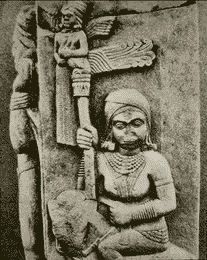
A silent interior, created in rock, with the wind whistling through the grilled windows; this was the most perfect place for a contemplative lifestyle. The man gazed at the idol, its beauty filled the air with energy, giving him a sense of awakening and a connection he had never felt before. He suddenly knew, this was his life, this was his goal and this was the only reason for his birth.
Life took a turn, for the worse for others, but for him it was different. The meaning of life had brought in new zest, new contemplation, new curiosity and all of this was triggered by the presence of divinity within the emblem that resided in this temple. The lap of nature had everything to offer. The waterfalls provided the pure water for abhishekam, the animals provided tender meat, and the flowers were the fragrance in His home and the herbs bloomed into a different fragrance bringing purity into the air, a freshness that was so divine, so new and so alive that the earth appeared most fertile and in full bloom.
Within this paradise the man contemplated, probably not in sacred syllables, or mula mantras or bija mantras that were recited but the Lord was offered the best of everything. As life passed by, the man raised each flower to the lord in worship, offering it as part of his very own heart, surrendering to the Lord.
My heart merges into you O Lord Shiva
My heart ceases to be with me any more
You have stolen the only thing I ever possessed,
Love, deep love for you O Lord.
As the puja continued, the flowers gracefully fell over the sacred stone, decorating Him and draping Him in a dress of color and fragrance. Color that dressed the Lord in brightness, fragrance that enveloped the room into potency, into a space where the air stood still and the lamp glowed brighter than before.
The man looked up at the Lord again, tears rolled down his eyes as his heart melted into divine song. He closed his eyes and burst into tune, sweetness rained in the room, echoing among the walls as they descended as a garland of letters on to the very emblem. When he opened his eyes, the Lord stared at him. Twinkling eyes, full of life and clarity… a different kind of clarity coupled with purity as they stared on at him. The Lord and the man stared at each other. This was a divine moment, one that is scarcely granted to any devotee, one that is felt once in a million years. The man’s heart sank; he was blessed to be given this divine vision. He picked up a vilva patra and placed it on each of his eyes, and then on his forehead and placed it back on the peetha.
To the bright eyes of the Lord
These are my eyes, I offer in each leaf of this vilva
I surrender to you, I seek no other vision
My sight has gone, I see only you
Divinity, surrounding my soul, capturing my imagination
Capturing my heart, soul and vision,
I see only you Lord, I can see only you.
This Vilva I offer to you, are my eyes, my life, my being, me
As he placed the sacred vilva on the peetha and raised his head, the eyes of the Lord bled, tears of a different kind rolled down, tears in blood that emoted to his surrender. The hunter looked up, with pain in his heart, over the Lord’s plight, over his suffering and tried to stop the bleeding with all the herbs he could find, crushing them to paste… yet they continued to bleed.
He raised his arrow, and just as the vilva leaf signified the three eyed Lord Trayambakeshawara, he dug out of his socket, the sun, his eye, the glowing radiance and placed it over the bleeding eye of the Lord. It was a moment of lull, the Lord twinkled again, beautiful eyes as the Sun and Moon glowed from within the Linga. The heart stopped a beat, as the hunter overjoyed over his Lord’s eye danced around the room, little aware that he now bled in the socket. When he stopped to look at the Lord, the other eye now began to bleed.

It was simple. He had the solution. He took out the arrow and as he raised his foot and placed it at the Lord’s bleeding eye, he aimed the arrow to cull out the moon, his eye from its socket. This was surrender, where the self feels no pain, nor loss, nor sorrow nor time nor fear, nor greed; this was a state to be in.
Oh Lord, the vilva, a significance of my own eyes
I offer to thee, my very own fire, sun and moon.
Here take my eyes, for I have seen thee,
Divine vision, I need not see no more
You are all I wanted to see,
I have lived for this moment.
As he drew the arrow close, the three eyed Lord, appeared, transforming the room into a moment in heaven. The power surged, the moment weakened every nerve in the man, the room glowed in sacred light, the world halted, the wind stopped, the silence overpowered the room, the emblem shined and the hunter was gone. A moment in history, a moment of life, a moment of true meaning, a moment divine, a moment felt and a moment never to come back. This is the moment of true worthwhile living.
Related links:
Kalahasti - the land where Vayu is felt
Photo courtesy: Shaivam.org





















